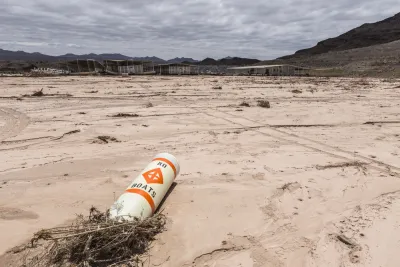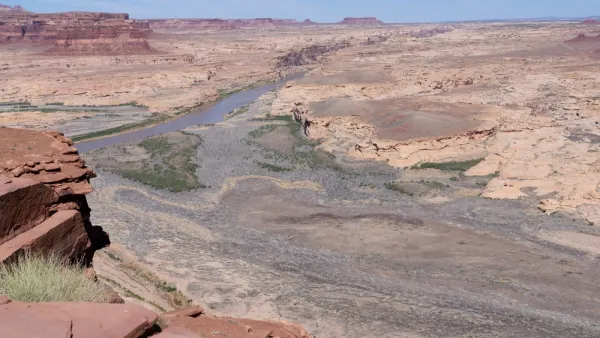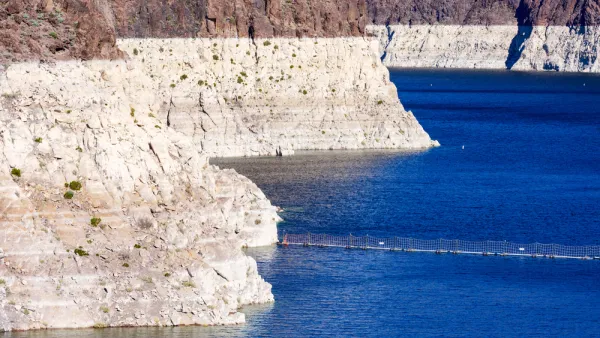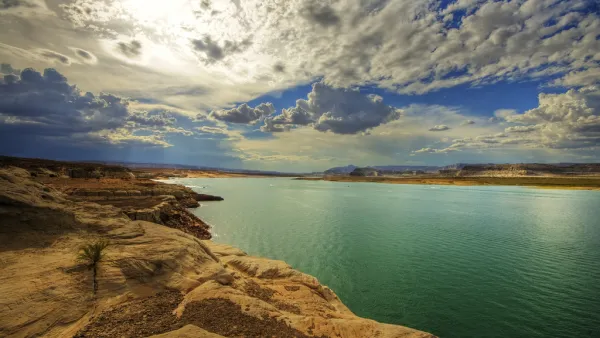The first-of-its-kind declaration triggers major water cutbacks for Arizona farmers and reduced allocations for Nevada and Mexico.

With water in Lake Mead at a critically low level – the lowest in the reservoir's nearly hundred-year history – the U.S. Bureau of Reclamation has declared a water shortage, triggering "mandatory cutbacks next year that will bring major challenges for Arizona farmers and reduce the water allotments of Nevada and Mexico." As reported by Ian James and Zayna Syed, the declaration "has been anticipated for months and was triggered by the spiraling decline of Lake Mead, which stores water used by Arizona, Nevada, California and Mexico." In particular, "[f]armers in part of central Arizona will face major cutbacks in water deliveries next year, and they’re preparing for the supplies to be entirely shut off in 2023."
"The reductions are taking effect under a 2019 agreement called the Drought Contingency Plan, which was aimed at reducing the risks of Lake Mead falling to critical lows. But as extreme heat and unrelenting drought have persisted across much of the watershed, the levels of the Colorado’s largest reservoirs have fallen faster than had been expected." The river "provides water for cities, tribal nations and about 4.5 million acres of farmland from Wyoming to the U.S.-Mexico border. About 70% of the water diverted from the river in the U.S. is used for agriculture, flowing to fields of hay and cotton, fruit orchards and farms that produce much of the country’s winter vegetables."
But the Colorado's water "has long been chronically overallocated under the 1922 Colorado River Compact and subsequent agreements, with more water promised on paper than what the river can supply in an average year." J.B. Hamby, vice president of California's Imperial Irrigation District, which holds the largest single water entitlement on the river, said "everyone needs to recognize the Colorado River is now in 'an era of limits' that requires everyone along the river to understand that water use must be limited," while some conservationists "have long called for the government to drain Lake Powell at Glen Canyon Dam and instead store the water downstream in a single reservoir at Lake Mead." The new federal infrastructure bill "includes money to improve so-called natural infrastructure, including forests, watersheds and underground aquifers, which could help bolster the supply, or at least slow the decline" of water supplies in the region.
FULL STORY: First-ever water shortage on the Colorado River will bring cuts for Arizona farmers

Analysis: Cybertruck Fatality Rate Far Exceeds That of Ford Pinto
The Tesla Cybertruck was recalled seven times last year.

National Parks Layoffs Will Cause Communities to Lose Billions
Thousands of essential park workers were laid off this week, just before the busy spring break season.

Retro-silient?: America’s First “Eco-burb,” The Woodlands Turns 50
A master-planned community north of Houston offers lessons on green infrastructure and resilient design, but falls short of its founder’s lofty affordability and walkability goals.

Test News Post 1
This is a summary

Analysis: Cybertruck Fatality Rate Far Exceeds That of Ford Pinto
The Tesla Cybertruck was recalled seven times last year.

Test News Headline 46
Test for the image on the front page.
Urban Design for Planners 1: Software Tools
This six-course series explores essential urban design concepts using open source software and equips planners with the tools they need to participate fully in the urban design process.
Planning for Universal Design
Learn the tools for implementing Universal Design in planning regulations.
EMC Planning Group, Inc.
Planetizen
Planetizen
Mpact (formerly Rail~Volution)
Great Falls Development Authority, Inc.
HUDs Office of Policy Development and Research
NYU Wagner Graduate School of Public Service




























